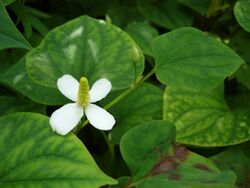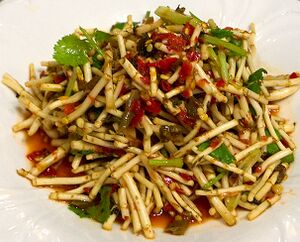Biology:Houttuynia cordata
| Houttuynia cordata | |
|---|---|

| |
| Scientific classification | |
| Kingdom: | Plantae |
| Clade: | Tracheophytes |
| Clade: | Angiosperms |
| Clade: | Magnoliids |
| Order: | Piperales |
| Family: | Saururaceae |
| Genus: | Houttuynia |
| Species: | H. cordata
|
| Binomial name | |
| Houttuynia cordata | |
Houttuynia cordata, also known as fish mint, fish leaf, rainbow plant, chameleon plant, heart leaf, fish wort, or Chinese lizard tail, is one of two species in the genus Houttuynia (the other being H. emeiensis). It is a flowering plant native to Southeast Asia.[1] It grows in moist, shady locations.[2] It was named after Martinus Houttuyn.
Growth
Houttuynia cordata is a herbaceous perennial plant that can grow to 0.6–1 m (2 ft 0 in–3 ft 3 in), spreading up to 1 m (3 ft 3 in).[2][1] The proximal part of the stem is trailing and produces adventitious roots, while the distal part of the stem grows vertically. The leaves are alternate, broadly heart-shaped, 4–9 cm (1 1⁄2–3 1⁄2 in) long and 3–8 cm (1–3 in) broad. Its flowers are greenish-yellow and borne on a terminal spike 2–3 cm (3⁄4–1 1⁄4 in) long with four to six large white basal bracts.[2][1] It normally blooms in the summer.
It is considered an invasive plant because of its ability to regrow rhizomes from any segment of its foliage.[3]
Cultivation
Houttuynia cordata grows in moist to wet soil or slightly submerged in water, as long as it is exposed partially or fully to the sun.[2][1] It can become invasive in gardens and difficult to eradicate as their roots run deep and actively spread. It propagates by division.
It is usually found in one of its cultivated forms in temperate gardens. The 'Chameleon' variety (synonymous with H.cordata 'Court Jester', 'Tricolour', and 'Variegata') is slightly less vigorous than the parent species, with stubbier leaves mottled in both yellow and red. Another common variety, 'Flore Pleno', has masses of white bracts and retains the vigor of the parent species.
Houttuynia cordata has been naturalized in North America.[4]
Usage
Culinary use

It is commonly grown as a leaf vegetable, and is used as a fresh herbal garnish.[2] The leaf has an unusual taste from its volatile oil decanoyl acetaldehyde, a taste that is often described as "fishy", earning it the nickname "fish mint".
In northeastern India, the leaves are commonly used in salads, salsas, or cooked with other vegetables, and as a garnish over side dishes. The tender roots can also be ground into chutneys along with dry meat or fish, chilies, and tamarind. It is taken raw as salad and cooked along with fish as fish curry. In Japan and Korea, the dried leaves may be used as a herbal tea. It is called dokudami-cha (どくだみ茶) in Japan and eoseongcho cha (어성초차) in Korea.
In Vietnamese cuisine, the plant is called diếp cá and is used with grilled meat and noodle salad dishes.[5] Fish mint may be used as a garnish with several Vietnamese dishes, such as gỏi cuốn, stir-fried beef with fish mint salad, and bánh xèo.[6]
Zhé'ěrgēn (Chinese: 折耳根, "broken ear-root") is the edible rhizome of Houttuynia cordata (yúxīngcǎo; 魚腥草; "fish-smelling grass") with a fresh, spicy, peppery flavour that is used in southwestern Chinese cuisine, i.e. that of Guizhou, Sichuan, Yunnan and western Guangxi. Typically the leaves are eaten in Sichuan and the root in Guizhou. Zhé'ěrgēn fried with larou (cured pork belly) is one of the staple dishes of Guizhou.
Notable uses include:
- part of the extensive fried rice cuisine of Guizhou
- a condiment to migan and mixian noodles when served in broth
- as a component of dipping sauces used with the Shiping and Jianshui tradition of barbecued tofu
- raw consumption as part of cold-tossed salads, when it is most frequently combined with coriander, vinegar, fresh chilli, and soy sauce.
The leaves are also a little peppery and are frequently consumed in the region.
Traditional medicine
Houttuynia cordata was used in traditional Chinese medicine, including by Chinese scientists in an attempt to treat SARS[7] and various other disorders,[8] although there is no high-quality clinical research to confirm such uses are safe or effective, as of 2018. When administered via injection, H. cordata can cause severe allergic reactions.[9]
Aroma profile
Chemical compounds that contribute to the aroma of H. cordata include β-myrcene[10][11] and 2-undecanone.[12]
See also
- Kampo herb list
- Sichuan cuisine
- Yunnan cuisine
References
- ↑ 1.0 1.1 1.2 1.3 "Houttuynia cordata, Thunb.". KewScience, The Royal Horticultural Society, UK. 2018. http://powo.science.kew.org/taxon/urn:lsid:ipni.org:names:927252-1.
- ↑ 2.0 2.1 2.2 2.3 2.4 "Houttuynia cordata Thunb.". Plants for a Future. 2012. https://www.pfaf.org/user/plant.aspx?latinname=Houttuynia+cordata.
- ↑ "Houttuynia cordata (Chameleon Plant, Rainbow Plant) | North Carolina Extension Gardener Plant Toolbox". https://plants.ces.ncsu.edu/plants/houttuynia-cordata/.
- ↑ Global Invasive Species Database: Houttuynia cordata, accessed 2008-07-06
- ↑ Vietnamese Herbs: Fish Mint, Accessed 9 October 2018.
- ↑ NPR Inc.:Banh Xeo (Sizzling Crepes), Accessed 10 October 2018
- ↑ Lau, K. M; Lee, K. M; Koon, C. M; Cheung, C. S; Lau, C. P; Ho, H. M; Lee, M. Y; Au, S. W et al. (2008). "Immunomodulatory and anti-SARS activities of Houttuynia cordata". Journal of Ethnopharmacology 118 (1): 79–85. doi:10.1016/j.jep.2008.03.018. PMID 18479853.
- ↑ Kumar, M; Prasad, S. K; Hemalatha, S (2014). "A current update on the phytopharmacological aspects of Houttuynia cordata Thunb". Pharmacognosy Reviews 8 (15): 22–35. doi:10.4103/0973-7847.125525. PMID 24600193.
- ↑ Wang, L; Cui, X; Cheng, L; Yuan, Q; Li, T; Li, Y; Deng, S; Shang, H et al. (2010). "Adverse events to Houttuynia injection: A systematic review". Journal of Evidence-Based Medicine 3 (3): 168–76. doi:10.1111/j.1756-5391.2010.01091.x. PMID 21349062.
- ↑ Lu, HongmeiExpression error: Unrecognized word "etal". (2006). "Variation in Chemical Composition and Antibacterial Activities of Essential Oils from Two Species of Houttuynia Thunb". Chemical & Pharmaceutical Bulletin 54 (7): 936–940. doi:10.1248/cpb.54.936. PMID 16819207.
- ↑ Ch, Muhammad IshtiaqExpression error: Unrecognized word "etal". (2007). "Gas Chromatographic/Mass Spectrometric Analysis of the Essential Oil of Houttuynia cordata Thunb by Using On-Column Methylation with Tetramethylammonium Acetate". Journal of AOAC International 90 (1): 60–67. doi:10.1093/jaoac/90.1.60. PMID 17373437.
- ↑ Liang, Minmin et al. (2005). "Gas chromatography–mass spectrometry analysis of volatile compounds from Houttuynia cordata Thunb after extraction by solid-phase microextraction, flash evaporation and steam distillation". Analytica Chimica Acta 531 (1): 97–104. doi:10.1016/j.aca.2004.09.082. http://ir.rcees.ac.cn/handle/311016/23180.
External links
| Wikimedia Commons has media related to Houttuynia cordata. |
- Flora, The Gardener's Bible, ABC Publishing, Ultimo, NSW, Australia, 2006 ISBN:0-7333-1439-2
Wikidata ☰ Q164091 entry
 |



